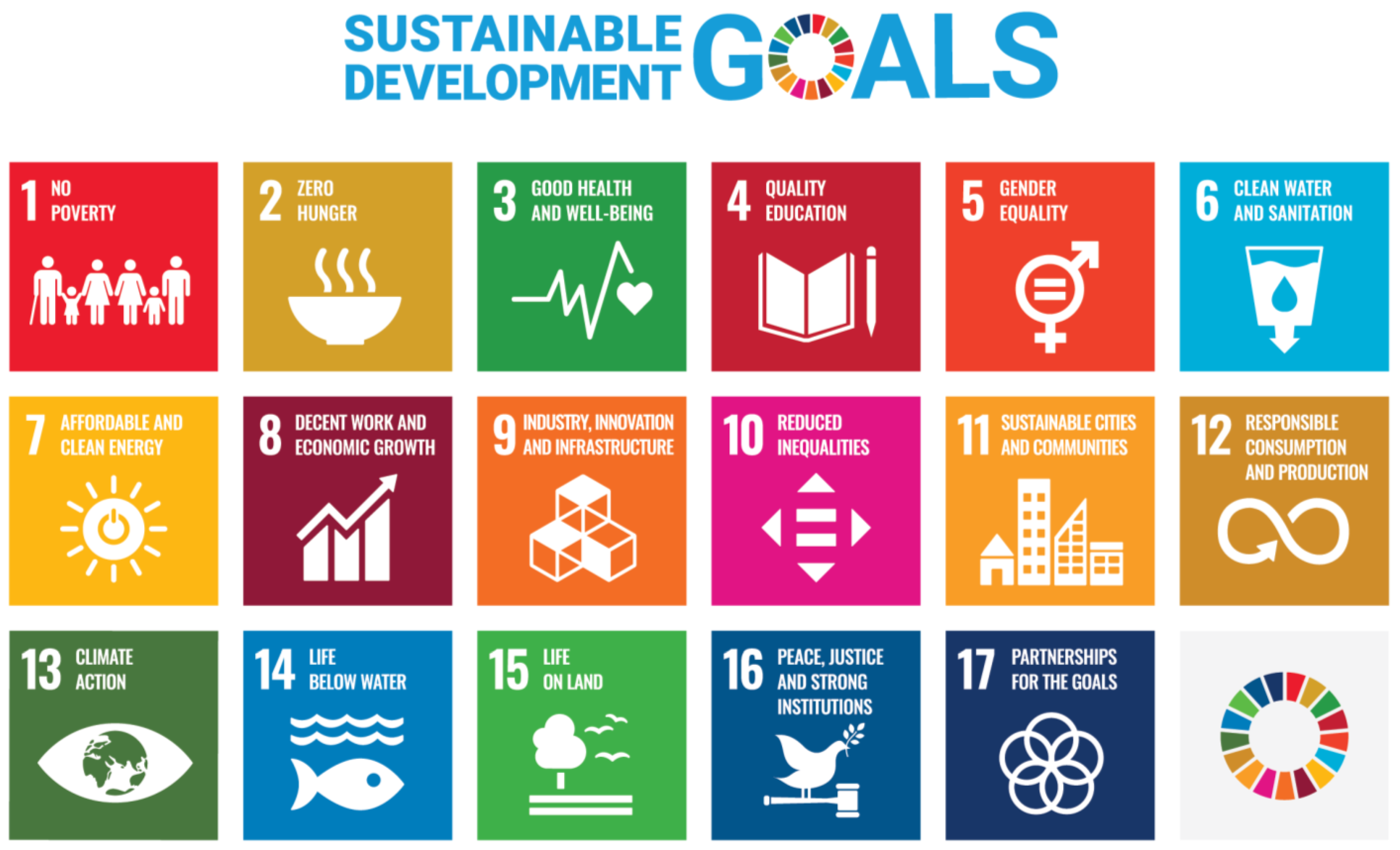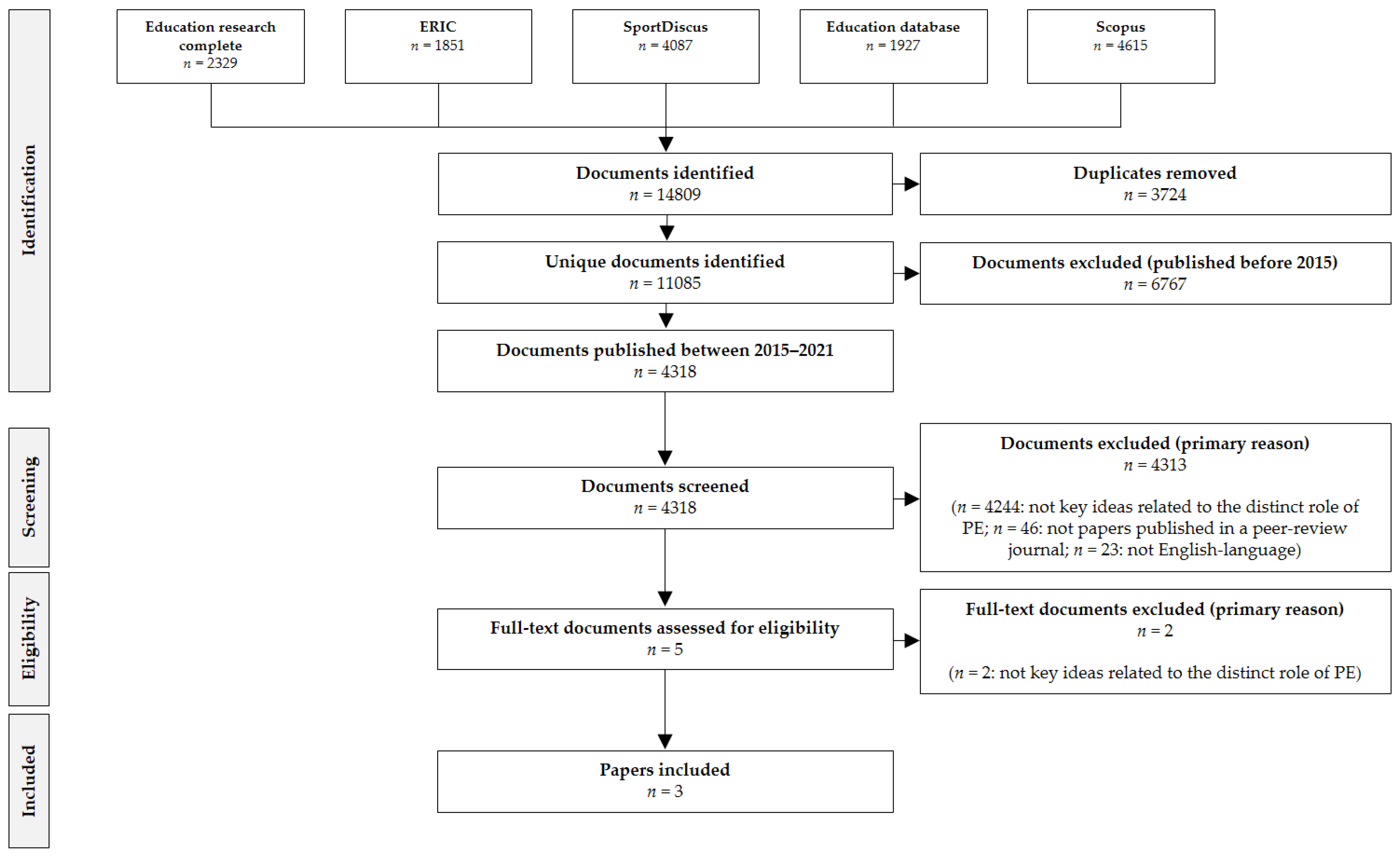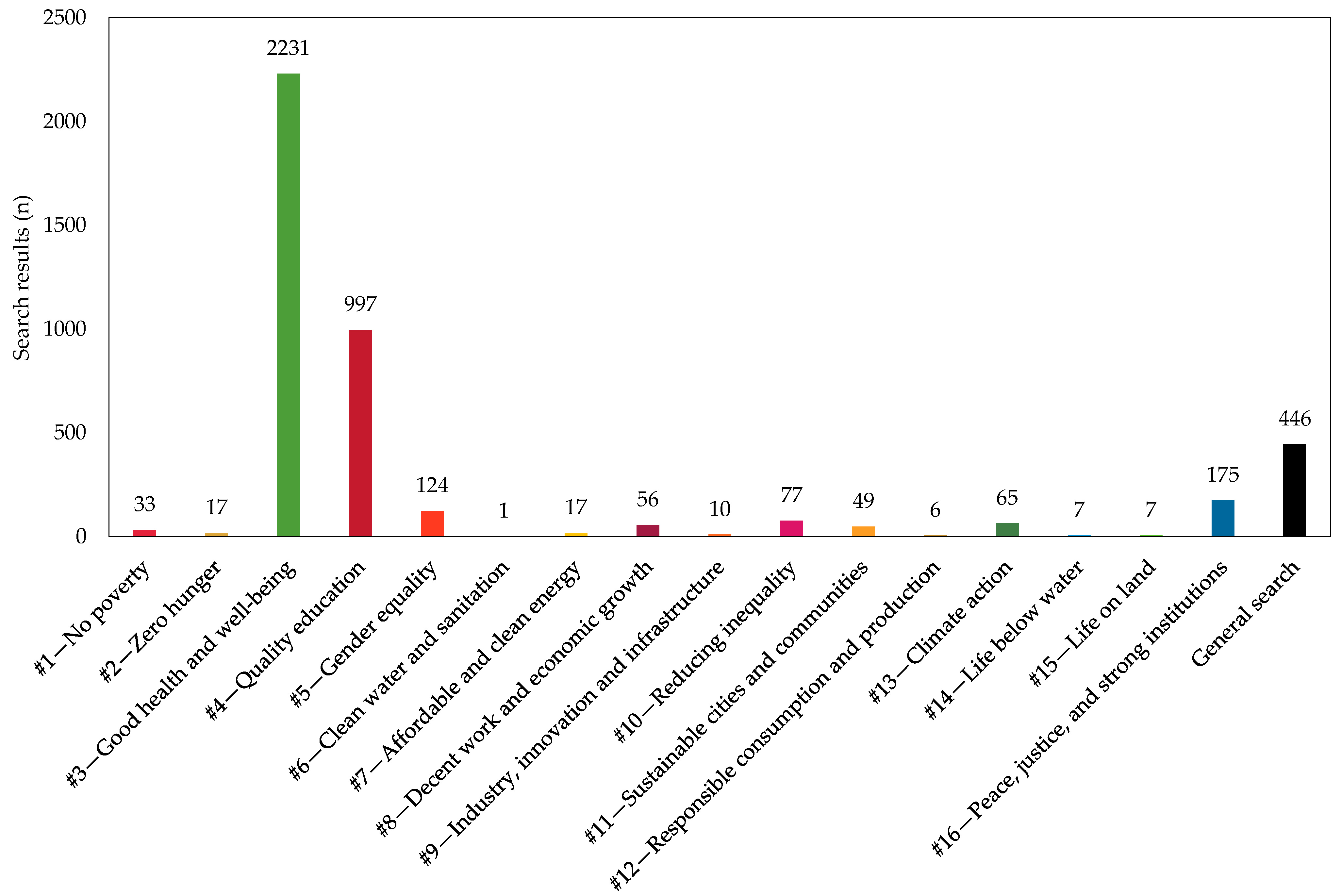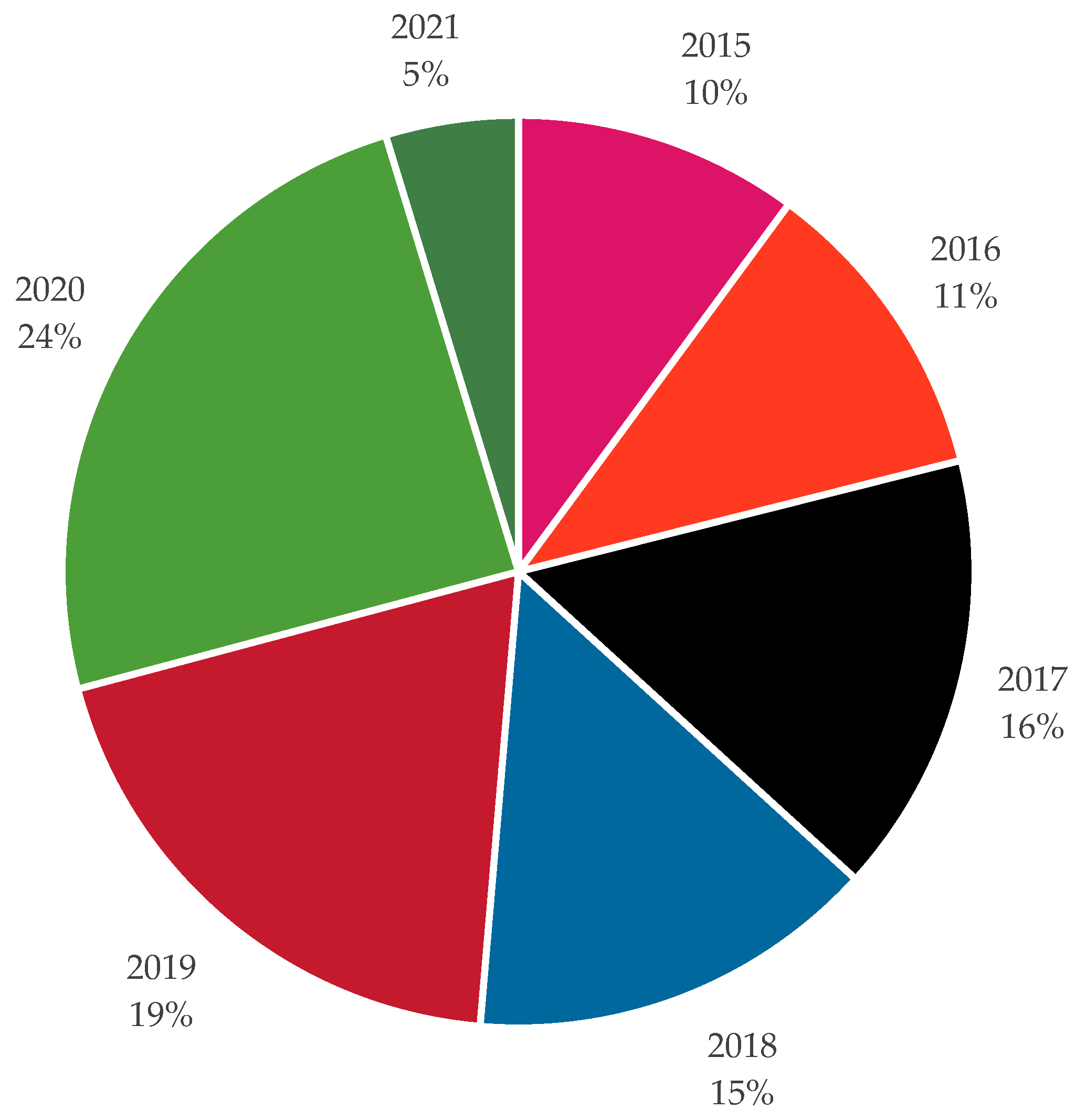The Distinct Role of Physical Education in the Context of Agenda 2030 and Sustainable Development Goals: An Explorative Review and Suggestions for Future Work
Abstract
1. Introduction
1.1. Agenda 2030 and Education, Physical Activity, Sport and Physical Education
…encouraging the transformation of education so that it is able to contribute effectively to the reorientation of societies towards sustainable development. This requires a reorientation of education systems and structures, as well as a reframing of teaching and learning. ESD concerns the core of teaching and learning and should not be considered as an add-on to existing curriculum or educational practices.
Sport is also an important enabler of sustainable development. We recognize the growing contribution of sport to the realization of development and peace in its promotion of tolerance and respect and the contributions it makes to the empowerment of women and of young people, individuals and communities as well as to health, education and social inclusion objectives.
1.2. The Present Paper
2. Materials and Methods
2.1. Systematic Search
2.1.1. Electronic Databases
2.1.2. Selection of Papers and Data Extraction
3. Results
3.1. Results from the Systematic Search
3.2. Papers Selected for Inclusion
4. Discussion
4.1. Suggestions on Future Work
4.2. Strengths and Limitations
5. Conclusions
Supplementary Materials
Author Contributions
Funding
Institutional Review Board Statement
Informed Consent Statement
Data Availability Statement
Acknowledgments
Conflicts of Interest
Appendix A
| Search String | |
|---|---|
| Sustainable Development Goals | |
| #4—Quality education | TI (((school OR education OR educational) AND (“school attendance” OR “school enrollment” OR “school enrolment” OR “inclusive education” OR “educational inequality” OR “education quality” OR “educational enrolment” OR “educational enrollment” OR “adult literacy” OR “numeracy rate” OR “educational environment” OR “educational access” OR (“development aid” AND “teacher training”) OR “early childhood education” OR “basic education” OR “affordable education” OR “educational financial aid” OR “school safety” OR “safety in school” OR ( “learning opportunities” AND (“gender disparities” OR empowerment)) OR (“learning opportunity” AND (“gender disparities” OR empowerment)) OR “youth empowerment” OR “women empowerment” OR “equal opportunities” OR “child labour” OR “child labor” OR “discriminatory” OR “educational inequality” OR “educational gap” OR (“poverty trap” AND “schooling”) OR “special education needs” OR “inclusive education system” OR (“schooling” AND (“gender disparities” OR “ethnic disparities” OR “racial disparities”)) OR “education exclusion” OR “education dropouts” OR “global citizenship” OR “sustainable development education” OR “environmental education” OR “education policy” OR “educational policies” OR “international education” OR “education reform” OR (“educational reform” AND “developing countries”) OR “educational governance” OR (“developing countries” AND “school effects”) OR “education expenditure” OR “foreign aid” OR (“teacher training” AND “developing countries”) OR “teacher attrition”)) NOT “health literacy”) OR SU (((school OR education OR educational) AND (“school attendance” OR “school enrollment” OR “school enrolment” OR “inclusive education” OR “educational inequality” OR “education quality” OR “educational enrolment” OR “educational enrollment” OR “adult literacy” OR “numeracy rate” OR “educational environment” OR “educational access” OR (“development aid” AND “teacher training”) OR “early childhood education” OR “basic education” OR “affordable education” OR “educational financial aid” OR “school safety” OR “safety in school” OR (“learning opportunities” AND (“gender disparities” OR empowerment)) OR (“learning opportunity” AND (“gender disparities” OR empowerment)) OR “youth empowerment” OR “women empowerment” OR “equal opportunities” OR “child labour” OR “child labor” OR “discriminatory” OR “educational inequality” OR “educational gap” OR (“poverty trap” AND “schooling”) OR “special education needs” OR “inclusive education system” OR (“schooling” AND (“gender disparities” OR “ethnic disparities” OR “racial disparities”)) OR “education exclusion” OR “education dropouts” OR “global citizenship” OR “sustainable development education” OR “environmental education” OR “education policy” OR “educational policies” OR “international education” OR “education reform” OR (“educational reform” AND “developing countries”) OR “educational governance” OR (“developing countries” AND “school effects”) OR “education expenditure” OR “foreign aid” OR (“teacher training” AND “developing countries”) OR “teacher attrition”)) NOT “health literacy”) OR AB (((school OR education OR educational) AND (“school attendance” OR “school enrollment” OR “school enrolment” OR “inclusive education” OR “educational inequality” OR “education quality” OR “educational enrolment” OR “educational enrollment” OR “adult literacy” OR “numeracy rate” OR “educational environment” OR “educational access” OR (“development aid” AND “teacher training”) OR “early childhood education” OR “basic education” OR “affordable education” OR “educational financial aid” OR “school safety” OR “safety in school” OR (“learning opportunities” AND (“gender disparities” OR empowerment)) OR (“learning opportunity” AND (“gender disparities” OR empowerment)) OR “youth empowerment” OR “women empowerment” OR “equal opportunities” OR “child labour” OR “child labor” OR “discriminatory” OR “educational inequality” OR “educational gap” OR (“poverty trap” AND “schooling”) OR “special education needs” OR “inclusive education system” OR (“schooling” AND (“gender disparities” OR “ethnic disparities” OR “racial disparities”)) OR “education exclusion” OR “education dropouts” OR “global citizenship” OR “sustainable development education” OR “environmental education” OR “education policy” OR “educational policies” OR “international education” OR “education reform” OR (“educational reform” AND “developing countries”) OR “educational governance” OR (“developing countries” AND “school effects”) OR “education expenditure” OR “foreign aid” OR (“teacher training” AND “developing countries”) OR “teacher attrition”)) NOT “health literacy”) OR KW (((school OR education OR educational) AND (“school attendance” OR “school enrollment” OR “school enrolment” OR “inclusive education” OR “educational inequality” OR “education quality” OR “educational enrolment” OR “educational enrollment” OR “adult literacy” OR “numeracy rate” OR “educational environment” OR “educational access” OR (“development aid” AND “teacher training”) OR “early childhood education” OR “basic education” OR “affordable education” OR “educational financial aid” OR “school safety” OR “safety in school” OR (“learning opportunities” AND (“gender disparities” OR empowerment)) OR (“learning opportunity” AND (“gender disparities” OR empowerment)) OR “youth empowerment” OR “women empowerment” OR “equal opportunities” OR “child labour” OR “child labor” OR “discriminatory” OR “educational inequality” OR “educational gap” OR (“poverty trap” AND “schooling”) OR “special education needs” OR “inclusive education system” OR (“schooling” AND (“gender disparities” OR “ethnic disparities” OR “racial disparities”)) OR “education exclusion” OR “education dropouts” OR “global citizenship” OR “sustainable development education” OR “environmental education” OR “education policy” OR “educational policies” OR “international education” OR “education reform” OR (“educational reform” AND “developing countries”) OR “educational governance” OR (“developing countries” AND “school effects”) OR “education expenditure” OR “foreign aid” OR (“teacher training” AND “developing countries”) OR “teacher attrition”)) NOT “health literacy”) AND “physical education” |
| General search | |
| Sustainability, AGENDA 2030 and Millennium Development Goals | Education research complete: “physical education” AND (sustainab* OR “agenda 2030” OR “Millennium Development Goals”) Eric: “physical education” AND (sustainab* OR “agenda 2030” OR “Millennium Development Goals”) SportDiscus: “physical education” AND (sustainab* OR “agenda 2030” OR “Millennium Development Goals”) Education database: noft(“physical education” AND (sustainab* OR “agenda 2030”)) Scopus: TITLE-ABS-KEY (“physical education” AND (sustainab* OR “agenda 2030” OR “Millennium Development Goals”)) |
References
- Hardman, K.; Murphy, C.; Routen, A.C.; Tones, S. World-Wide Survey of School Physical Education: Final Report; UNESCO: Paris, France, 2014. [Google Scholar]
- Bailey, R.; Armour, K.; Kirk, D.; Jess, M.; Pickup, I.; Sandford, R.; Education, B.P.; Sport Pedagogy Special Interest Group. The educational benefits claimed for physical education and school sport: An academic review. Res. Pap. Educ 2009, 24, 1–27. [Google Scholar] [CrossRef]
- Hollis, J.L.; Sutherland, R.; Williams, A.J.; Campbell, E.; Nathan, N.; Wolfenden, L.; Morgan, P.J.; Lubans, D.R.; Gillham, K.; Wiggers, J. A systematic review and meta-analysis of moderate-to-vigorous physical activity levels in secondary school physical education lessons. Int. J. Behav. Nutr. Phys. Act. 2017, 14, 52. [Google Scholar] [CrossRef] [PubMed]
- Hollis, J.L.; Williams, A.J.; Sutherland, R.; Campbell, E.; Nathan, N.; Wolfenden, L.; Morgan, P.J.; Lubans, D.R.; Wiggers, J. A systematic review and meta-analysis of moderate-to-vigorous physical activity levels in elementary school physical education lessons. Prev. Med. 2016, 86, 34–54. [Google Scholar] [CrossRef] [PubMed]
- Sallis, J.F.; McKenzie, T.L.; Beets, M.W.; Beighle, A.; Erwin, H.; Lee, S. Physical education’s role in public health: Steps forward and backward over 20 years and hope for the future. Res. Q. Exerc. Sport 2012, 83, 125–135. [Google Scholar] [CrossRef] [PubMed]
- McKenzie, T.L.; Lounsbery, M.A.F. The pill not taken: Revisiting physical education teacher effectiveness in a public health context. Res. Q. Exerc. Sport 2014, 85, 287–292. [Google Scholar] [CrossRef] [PubMed]
- Beni, S.; Fletcher, T.; Ní Chróinín, D. Meaningful experiences in physical education and youth sport: A review of the literature. Quest 2017, 69, 291–312. [Google Scholar] [CrossRef]
- Opstoel, K.; Chapelle, L.; Prins, F.J.; De Meester, A.; Haerens, L.; van Tartwijk, J.; De Martelaer, K. Personal and social development in physical education and sports: A review study. Eur. Phys. Educ. Rev. 2019, 26, 797–813. [Google Scholar] [CrossRef]
- Tinning, R. The idea of physical education: A memetic perspective. Phys. Educ. Sport Pedagog. 2012, 17, 115–126. [Google Scholar] [CrossRef]
- Larsson, H.; Karlefors, I. Physical education cultures in Sweden: Fitness, sports, dancing … learning? Sport Educ. Soc. 2015, 20, 573–587. [Google Scholar] [CrossRef]
- Nabaskues-Lasheras, I.; Usabiaga, O.; Lozano-Sufrategui, L.; Drew, K.J.; Standal, Ø.F. Sociocultural processes of ability in physical education and physical education teacher education: A systematic review. Eur. Phys. Educ. Rev. 2019, 26, 865–884. [Google Scholar] [CrossRef]
- Redelius, K.; Quennerstedt, M.; Öhman, M. Communicating aims and learning goals in physical education: Part of a subject for learning? Sport Educ. Soc. 2015, 20, 641–655. [Google Scholar] [CrossRef]
- Lundvall, S.; Meckbach, J. Mind the gap: Physical education and health and the frame factor theory as a tool for analysing educational settings. Phys. Educ. Sport Pedagog. 2008, 13, 345–364. [Google Scholar] [CrossRef]
- Penney, D.; Jess, M. Physical education and physically active lives: A lifelong approach to curriculum development. Sport Educ. Soc. 2004, 9, 269–287. [Google Scholar] [CrossRef]
- Ennis, C.D. Knowledge, transfer, and innovation in physical literacy curricula. Sport Health Sci. 2015, 4, 119–124. [Google Scholar] [CrossRef]
- Mong, H.H.; Standal, Ø.F. Didactics of health in physical education—A review of literature. Phys. Educ. Sport Pedagog. 2019, 24, 506–518. [Google Scholar] [CrossRef]
- Pühse, U.; Barker, D.; Brettschneider, W.D.; Feldmeth, A.K.; Gerlach, E.; McCuaig, L.; McKenzie, T.L.; Gerber, M. International approaches to health-oriented physical education—local health debates and differing conceptions of health. Int. J. Phys. Educ. 2011, 48, 2–15. [Google Scholar]
- Taylor, N.; Wright, J.; O’Flynn, G. Hpe teachers’ negotiation of environmental health spaces: Discursive positions, embodiment and materialism. Aust. Educ. Res. 2016, 43, 361–376. [Google Scholar] [CrossRef][Green Version]
- Taylor, N.; Wright, J.; O’Flynn, G. Embodied encounters with more-than-human nature in health and physical education. Sport Educ. Soc. 2019, 24, 914–924. [Google Scholar] [CrossRef]
- Olive, R.; Enright, E. Sustainability in the Australian health and physical education curriculum: An ecofeminist analysis. Sport Educ. Soc. 2021, 26, 389–402. [Google Scholar] [CrossRef]
- Johansson, M.; Hartig, T.; Staats, H. Psychological benefits of walking: Moderation by company and outdoor environment. Appl. Psychol. Health Well Being 2011, 3, 261–280. [Google Scholar] [CrossRef]
- Kirk, D. Physical Education Futures; Routledge: New York, NY, USA, 2010. [Google Scholar]
- Ferry, M. Physical education preservice teachers’ perceptions of the subject and profession: Development during 2005–2016. Phys. Educ. Sport Pedagog. 2018, 23, 358–370. [Google Scholar] [CrossRef]
- Larsson, L. Sport—And Preferably a Little More Sport: PE Student Teachers’ Encounter with Their Education. Ph.D. Thesis, Stockholm University, Stockholm, UK, 23 October 2009. [Google Scholar]
- Richards, K.A.R.; Templin, T.J.; Graber, K. The socialization of teachers in physical education: Review and recommendations for future works. Kinesiol. Rev. 2014, 3, 113–134. [Google Scholar] [CrossRef]
- Schantz, P.; Lundvall, S. Changing perspectives on physical education in Sweden: Implementing dimensions of public health and sustainable development. In Physical Education and Health: Global Perspectives and Best Practice, 1st ed.; Edginton, C., Chin, M.K., Eds.; Sagamore Publishing: Urbana, IL, USA, 2014; pp. 463–475. [Google Scholar]
- Transforming Our World: The 2030 Agenda for Sustainable Development. Available online: https://sustainabledevelopment.un.org/post2015/transformingourworld/publication (accessed on 30 July 2021).
- Education 2030: Incheon Declaration and Framework for Action Towards Inclusive and Equitable Quality Education and Lifelong Learning for All. Available online: https://iite.unesco.org/publications/education-2030-incheon-declaration-framework-action-towards-inclusive-equitable-quality-education-lifelong-learning/ (accessed on 30 July 2021).
- Shaping the Future We Want—UN Decade of Education for Sustainable Development (Final Report). Available online: https://sustainabledevelopment.un.org/index.php?page=view&type=400&nr=1682&menu=35 (accessed on 30 July 2021).
- Boström, M.; Andersson, E.; Berg, M.; Gustafsson, K.; Gustavsson, E.; Hysing, E.; Lidskog, R.; Löfmarck, E.; Ojala, M.; Olsson, J.; et al. Conditions for transformative learning for sustainable development: A theoretical review and approach. Sustainability 2018, 10, 4479. [Google Scholar] [CrossRef]
- World Health Organization. Global Action Plan on Physical Activity 2018–2030: More Active People for A Healthier World; World Health Organization: Geneva, Switzerland, 2018. [Google Scholar]
- United Nations Office on Sport for Development and Peace. Sport and the Sustainable Development Goals: An Overview Outlining the Contribution of Sport to the SDGs. Available online: https://www.un.org/sport/sites/www.un.org.sport/files/ckfiles/files/Sport_for_SDGs_finalversion9.pdf (accessed on 30 July 2021).
- Commonwhealth. Sport for Development and Peace and the 2030 Agenda for Sustainable Development. Available online: https://thecommonwealth.org/sdp-publications-and-resources (accessed on 30 July 2021).
- Howells, K. OECD Future of Education 2030: Making Physical Education Dynamic and Inclusive for 2030; OECD: Paris, France, 2019. [Google Scholar]
- Lindsey, I.; Darby, P. Sport and the sustainable development goals: Where is the policy coherence? Int. Rev. Sport Sociol. 2018, 54, 793–812. [Google Scholar] [CrossRef]
- Swedish National Agency for Education. Curriculum for the Compulsory School, Preschool Class and School-Age Educare (Revised 2018). Available online: https://www.skolverket.se/publikationer?id=3984 (accessed on 30 July 2021).
- Moher, D.; Liberati, A.; Tetzlaff, J.; Altman, D.G. Preferred reporting items for systematic reviews and meta-analyses: The prisma statement. PLoS Med. 2009, 6, e1000097. [Google Scholar] [CrossRef]
- Xiao, Y.; Watson, M. Guidance on conducting a systematic literature review. J. Plan. Educ. Res. 2017, 39, 93–112. [Google Scholar] [CrossRef]
- Grant, M.J.; Booth, A. A typology of reviews: An analysis of 14 review types and associated methodologies. Health Inf. Libr. J. 2009, 26, 91–108. [Google Scholar] [CrossRef] [PubMed]
- Jayabalasingham, B.; Boverhof, R.; Agnew, J.; Klein, L. Identifying Research Supporting the United Nations Sustainable Development Goals. Available online: https://data.mendeley.com/datasets/87txkw7khs/1 (accessed on 30 July 2021).
- Stern, C.; Jordan, Z.; McArthur, A. Developing the review question and inclusion criteria. Am. J. Nurs. 2014, 114, 53–56. [Google Scholar] [CrossRef]
- Baethge, C.; Goldbeck-Wood, S.; Mertens, S. SANRA—a scale for the quality assessment of narrative review articles. Res. Integr. Peer Rev. 2019, 4, 5. [Google Scholar] [CrossRef]
- Critical Appraisal Skills Programme. CASP Qualitative Studies Checklist. Available online: https://casp-uk.net/casp-tools-checklists/ (accessed on 15 September 2021).
- Baena-Morales, S.; Jerez-Mayorga, D.; Delgado-Floody, P.; Martínez-Martínez, J. Sustainable development goals and physical education. A proposal for practice-based models. Int. J. Environ. Res. Public Health 2021, 18, 2129. [Google Scholar] [CrossRef]
- Lynch, T. United nations sustainable development goals: Promoting health and well-being through physical education partnerships. Cogent Educ. 2016, 3, 1188469. [Google Scholar] [CrossRef]
- Dudley, D.; Cairney, J. Physical literacy: Answering the call for quality education and sustainable development. Prospects 2021, 50, 5–11. [Google Scholar] [CrossRef]
- Penney, D.; Jeanes, R.; O’Connor, J.; Alfrey, L. Re-theorising inclusion and reframing inclusive practice in physical education. Int. J. Incl. Educ. 2018, 22, 1062–1077. [Google Scholar] [CrossRef]
- Azzarito, L.; Macdonald, D.; Dagkas, S.; Fisette, J. Revitalizing the physical education social-justice agenda in the global era: Where do we go from here? Quest 2017, 69, 205–219. [Google Scholar] [CrossRef]
- Hinojo Lucena, F.J.; López Belmonte, J.; Fuentes Cabrera, A.; Trujillo Torres, J.M.; Pozo Sánchez, S. Academic Effects of the Use of Flipped Learning in Physical Education. Int. J. Environ. Res. Public Health 2020, 17, 276. [Google Scholar] [CrossRef]
- Calderón, A.; Meroño, L.; MacPhail, A. A student-centred digital technology approach: The relationship between intrinsic motivation, learning climate and academic achievement of physical education pre-service teachers. Eur. Phys. Educ. Rev. 2019, 26, 241–262. [Google Scholar] [CrossRef]
- McNeil, E.; Miller, J.; Littledyke, M. Education for sustainability in primary health and physical education. In Educating for Sustainability in Primary Schools: Teaching for the Future; Taylor, N., Quinn, F., Eames, C., Eds.; Sense Publishers: Rotterdam, the Netherlands, 2015; pp. 247–265. [Google Scholar]
- Truong, S. Expanding curriculum pathways between education for sustainability (efs) and health and physical education (hpe). In Reimagining Sustainability in Precarious Times; Malone, K., Truong, S., Gray, T., Eds.; Springer: Singapore, 2017; pp. 239–251. [Google Scholar]




| Electronic Database (n Papers) | Selection (n Papers) | |||||||
|---|---|---|---|---|---|---|---|---|
| Education Research Complete | ERIC | SportDiscus | Education Database | Scopus | Unique (Duplicates Removed) | Published between 2015 and 2021 | Included * | |
| #1—No poverty | 25 | 26 | 40 | 20 | 6 | 75 | 33 | 0 |
| #2—Zero hunger | 9 | 0 | 9 | 4 | 33 | 46 | 17 | 0 |
| #3—Good health and well-being | 1325 | 824 | 2259 | 1299 | 3033 | 6523 | 2231 | 0 |
| #4—Quality education | 571 | 694 | 817 | 315 | 629 | 2226 | 997 | 1 |
| #5—Gender equality | 86 | 86 | 157 | 56 | 138 | 346 | 124 | 0 |
| #6—Clean water and sanitation | 0 | 0 | 0 | 0 | 3 | 3 | 1 | 0 |
| #7—Affordable and clean energy | 5 | 2 | 16 | 2 | 49 | 68 | 17 | 0 |
| #8—Decent work and economic growth | 14 | 13 | 35 | 19 | 51 | 110 | 56 | 0 |
| #9—Industry, innovation and infrastructure | 0 | 1 | 1 | 0 | 16 | 16 | 10 | 0 |
| #10—Reducing inequality | 33 | 33 | 57 | 44 | 69 | 146 | 77 | 1 |
| #11—Sustainable cities and communities | 15 | 7 | 37 | 11 | 56 | 104 | 49 | 0 |
| #12—Responsible consumption and production | 3 | 1 | 7 | 1 | 4 | 13 | 6 | 0 |
| #13—Climate action | 41 | 43 | 59 | 38 | 88 | 143 | 65 | 0 |
| #14—Life below water | 2 | 1 | 4 | 1 | 11 | 17 | 7 | 0 |
| #15—Life on land | 1 | 0 | 10 | 2 | 8 | 20 | 7 | 0 |
| #16—Peace, justice, and strong institutions | 96 | 80 | 176 | 16 | 226 | 431 | 175 | 0 |
| General search | 103 | 40 | 403 | 99 | 195 | 798 | 446 | 3 |
| Citation Details | Aim | Type of Paper | Main Findings |
|---|---|---|---|
| Baena-Morales et al. [40] | To analyse and select the specific SDGs that can be implemented in the area of PE, and to relate these specific goals to the different PE practice-based models. | Critical review. | Of the 169 specific targets proposed in the SDGs, the authors concluded that 24 (14%) could be worked on in PE. These targets involved the following eight SDGs: good health and well-being (#3), quality education (#4), gender equality (#5), decent work and economic growth (#8), reducing inequality (#10), responsible consumption and production (#12), climate action (#13), and peace, justice, and strong institutions (#16). The authors, furthermore, presented a proposal for the relationship between these 24 targets and PE practice-based models as follows: content of curriculum model (n = 12 targets), cooperative learning model (n = 10 targets), personal and social responsibility model (n = 9 targets), adventure education model (n = 7 targets), self-construction material model (n = 6 targets), sports education model (n = 2 targets), and health education model (n = 1 target). |
| Dudley and Cairney [42] | To explore the concept of physical literacy, and how a special issue on physical literacy is addressing a range of UN agenda initiatives, including the UNESCO Quality PE Guidelines for Policymakers, and the UN 2030 SDGs. | Introductory to special issue. | In the context of a special issue on physical literacy, the authors present previous literature dealing with the importance of a quality pedagogy and the complex interactions of contemporary learning science’s impact on the construct and conceptualisation of physical literacy. In addition, how this will be critical if society and its educational institutions are to make any headway in addressing the SDGs. They suggest that physical literacy is the foundation of a quality PE agenda, and are currently related to notions of physical, affective, cognitive, and social learning that aligns with the SDG quality education (#4). |
| Lynch [41] | To provide insights into cross-sector partnerships, identified as essential for the implementation of the SDGs. | Case study. | A cross-sector partnerships program aimed to implement the SDGs good health and well-being (#3) and quality education (#4) by improving PETE through stronger partnerships between schools and universities, and a greater integration of theory and practice. The program that involved pre-service teachers who taught PE lessons to pupils in a low socio-economic rural area was successful and deemed significant to educators and governments who are challenged to rethink their connections between university courses, school experiences and community health promotion. |
Publisher’s Note: MDPI stays neutral with regard to jurisdictional claims in published maps and institutional affiliations. |
© 2021 by the authors. Licensee MDPI, Basel, Switzerland. This article is an open access article distributed under the terms and conditions of the Creative Commons Attribution (CC BY) license (https://creativecommons.org/licenses/by/4.0/).
Share and Cite
Fröberg, A.; Lundvall, S. The Distinct Role of Physical Education in the Context of Agenda 2030 and Sustainable Development Goals: An Explorative Review and Suggestions for Future Work. Sustainability 2021, 13, 11900. https://doi.org/10.3390/su132111900
Fröberg A, Lundvall S. The Distinct Role of Physical Education in the Context of Agenda 2030 and Sustainable Development Goals: An Explorative Review and Suggestions for Future Work. Sustainability. 2021; 13(21):11900. https://doi.org/10.3390/su132111900
Chicago/Turabian StyleFröberg, Andreas, and Suzanne Lundvall. 2021. "The Distinct Role of Physical Education in the Context of Agenda 2030 and Sustainable Development Goals: An Explorative Review and Suggestions for Future Work" Sustainability 13, no. 21: 11900. https://doi.org/10.3390/su132111900
APA StyleFröberg, A., & Lundvall, S. (2021). The Distinct Role of Physical Education in the Context of Agenda 2030 and Sustainable Development Goals: An Explorative Review and Suggestions for Future Work. Sustainability, 13(21), 11900. https://doi.org/10.3390/su132111900







